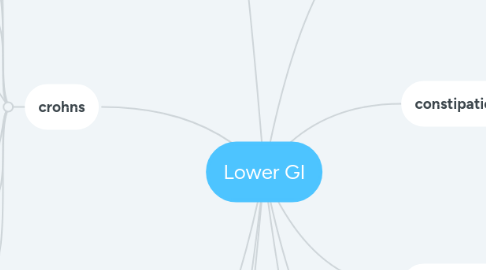
1. cancer (colorectal)
1.1. staging
1.1.1. stage 1- present
1.1.2. stage 2 - growing
1.1.3. stage 3 - in surrounding tissue
1.1.4. stage 4 - metastisicized
1.2. testing
1.2.1. CT
1.2.2. fecal occult blood test
1.2.3. sigmoidoscopy
1.2.4. endorectal ultrasoundography
1.2.5. CBC
1.2.6. liver function test
1.2.7. colonoscopy
1.3. treatment
1.3.1. surgical removal
1.3.2. possible ostomy req'd
1.4. Clinical manifrestations
1.4.1. Left side
1.4.1.1. sensation of incomplete evacuation
1.4.1.2. ribbon like BM
1.4.1.3. constipation/diarrhea
1.4.1.4. earlier obstruction symptoms
1.4.1.5. rectal bleeding
1.4.2. Right side
1.4.2.1. occult blood
1.4.2.2. weakness/fatigue
1.4.2.3. spasms/colic
1.4.2.4. asumptomatic
1.4.2.5. vague abdo discomfort/cramps
1.5. risk of metastisis to lungs, liver, brain
2. crohns
2.1. Ileum and Colon most common
2.1.1. inflammation of bowels leading to narrowing
2.2. CM
2.2.1. diarrhea, pain, distention, fever, fatigue, several BM daily
2.3. risk of fistulas
2.4. *Toxic Megacolon* (paralysis of colon)
2.4.1. symptoms
2.4.1.1. abdo distention, pain/tenderness, high fever, rapid heartrate, pallor
2.4.2. treatment
2.4.2.1. surgical removal of colon, antiinflammatory, antipyretic, bowel rest and decompression, IV fluids,
2.5. Studies/Tests
2.5.1. electrolyte imbalance, CBC, serum protein levels, stool cultures, increase TNFA levels
2.6. Meds
2.6.1. antimicrobials, corticosteroids (reduces inflammation) and immune suppressants
2.7. Treatment
2.7.1. (75%) most pts require it to drain abdominal abscess, failure to respond to therapy, to treat fistulas and intestinal obstructions, hemorrhage or perforations. Surgery produces remission but a high recurrence rate. Could require TPN
3. colitis
3.1. Ulceritive
3.2. CM
3.2.1. Stool will be loose/diarrhea, blood, mucous, multiple abscesses develop, weight loss, abdo pain, poor apetite
3.3. Treatment
3.4. Meds
3.4.1. aminosalicylates, antimicrobials, corticosteroids, immunosuppressants, biological and targeted therapies
3.5. Studies/Tests
3.5.1. CBC, risk of anemia,
4. ostomy
4.1. surgical opening of the colon through the abdomen
4.2. temporary of permanent
4.3. many different reasons
4.4. stool will appear different depending on where the ostomy is located (adverse, transverse, descending)
5. hernia
5.1. perforation of bowel through the abdominal wall
5.1.1. 4 types
5.1.2. surgery may or may not be required for treatment
5.1.3. risk of strangulation of intestines
5.1.4. avoid heavy lifting
6. diarrhea
6.1. test ele
6.2. risk of dehydration
6.3. increase fluid intake
7. constipation
7.1. increase fibre
7.2. increase fluids
7.3. stool softeners
7.4. enema
7.5. increased risk of obstruction
7.5.1. listen and palpate abdo
7.5.2. ? flatus

